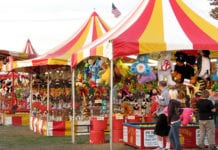We’ve talked about content, delivery, and relationships in an engaging children’s ministry environment. They are each important, but they can’t stand alone. The best environments seek synergy among these efforts.
This starts with a set list. When a band performs, they write a set list. They know what songs they’re singing, in what order, and how they’ll transition between each songs. Our ministries need something similar. Everyone leader in the room needs to know where they’re going and how they’ll get there during the hour they have with the kids. When leaders know where they’re going, chances are exponentially higher that they will actually get there.
By the time you get to the point where you’re developing your set list, you should have a bottom line and a list of possible ways to help kids remember that bottom line. This is different than a production sheet. Production sheets have all of the sound and light cues written into the flow of programming elements. A set list is just that – a list of what’s happening when to cue everyone as what’s going on and where the kids need to be.
Let’s get started on that set list with three questions:
1. Total Time: What’s the total amount of time that you need to fill?
Always plan on more than you’ll need. Most of us serve in environments where the service lengths are not as standard as we’d like. We usually planned for about 5-7 minutes over what we normally needed. 98% of the time we were fine.
2. Time for Each Element: How long will it take you to do each of the programming elements on your list?
You can’t do everything. Choose the best options that will get you to your bottom line. It’s OK if you choose fewer elements as long as they fit within your time frame and help kids know and apply the story.
3. Write your story: What is the best order for the elements we’ve chosen?
Think about the plot line of a movie. Directors and editors make important decisions about when they will reveal parts of the story; you should as well. Put the elements in an order that takes kids on an experience that keeps them wanting more.
A Sample Set List: Here’s a simple example of set list with some explanation as to why certain elements are in this particular order.
SMALL GROUP: The idea behind starting your hour off with small group is to thwart chaos. Think about it: As a parent would you feel more comfortable dropping your kids off into a room where everyone is running around looking like they’re about to bang into walls or each other or a room where the kids are active with a purpose?
Early Arriver – These are activities that kids can join as they come into the room. These can be games or small group activities that are open-ended so kids don’t miss something important if they aren’t there when you start.
Build Relationships – have small group leaders check in on how the kids are doing. Go around the circle and have kids share about the past week.
Teaser – At some point you need to start telling a story that leads to the bottom line. A teaser activity is one that doesn’t blatantly share the story or bottom line but hints at the topic for the day. For example: The story is a lesson on being thankful with the story of the 10 lepers. Maybe the activity is simply an open-ended question that has kids talk about a time when they went out of their way to say thanks to someone. This doesn’t give them the bottom line and doesn’t reveal the story too early. Keep the kids guessing!
Transition: When you call the kids to large group, play walk-in music that will help cue them to move to the next part of the morning. This should be a song or two that hints at the bottom line or topic for the day. The music should last long enough for everyone to get seated. You could also have a music video of some sort to help focus kid’s attention to the front of the stage.
LARGE GROUP:
Countdown: 10 seconds – no longer, no shorter. Kids can count along with this this. If you go for 30 seconds, it’s just too long.
Transition: When you call the kids to large group, play walk-in music that will help cue them to move to the next part of the morning. This should be a song or two that hints at the bottom line or topic for the day. The music should last long enough for everyone to get seated. You could also have a music video of some sort to help focus kid’s attention to the front of the stage.
Worship Songs: Two rockin’ songs that gets kids excited to be in the environment
Transition: Music bed out of the last song that will continue through the host welcome.
Welcome/Intro: Host introduces the topic with a story or a game. He doesn’t give away the bottom line. He helps keep attention and builds towards the story. This should be where the zany can come out. Have fun and keep the kids enjoying their time. Don’t create something that’s funny for the sake of being funny. Every element should serve the bottom line in your story.
Transition: Begin the introduction to the first song as the host is leaving the stage.
Worship Songs: One or two mid-tempo songs to set the mood for the story. These songs help the kids wind down after the fun of the welcome/intro.
Transition: Use a video trailer to set up the storyteller. This will refocus attention back to the stage after worship.
Message: The storyteller shares the main Bible story for the day and reveals the bottom line for the day.
Transition: Start music under prayer. As the storyteller begins to walk off the stage start the closing song.
Closing Song: One song that can serve as a response to what the kids just learned. This could be a theme song for the month or simply a worship song.
Transition: Have the host come up before the last notes of the song play.
Wrap-Up: The host comes out and brings it home with a word of application, has the kids repeat the bottom line, and dismisses kids to small group.
Transition: Walk-out music to cue kids as they move back into small groups.
SMALL GROUP: The focus of this part of the hour is to help the kids remember the bottom line and figure out how they can put the bottom line into practice throughout the week. If you have time, you should have an activity that covers each of the following:
Bible Story Review
Memory Verse Review
Application Game or Activity
Prayer – build relationships through praying for each other
CLOSING ACTIVITY: Activities may not take as much time as you thought. Equip your small group leaders with quiet games they can play in group if they’ve finish early. These serve as a way to keep the kids engaged as their parents arrive to pick them up.
Once you have your set list written out: Email it to everyone before the weekend, hand it out on Sundays, post it everywhere, and follow it! The set list is the plan that will keep you accountable to your story.
What do your set lists look like? I’d love to hear how you keep the story moving throughout your morning! Comment below!










